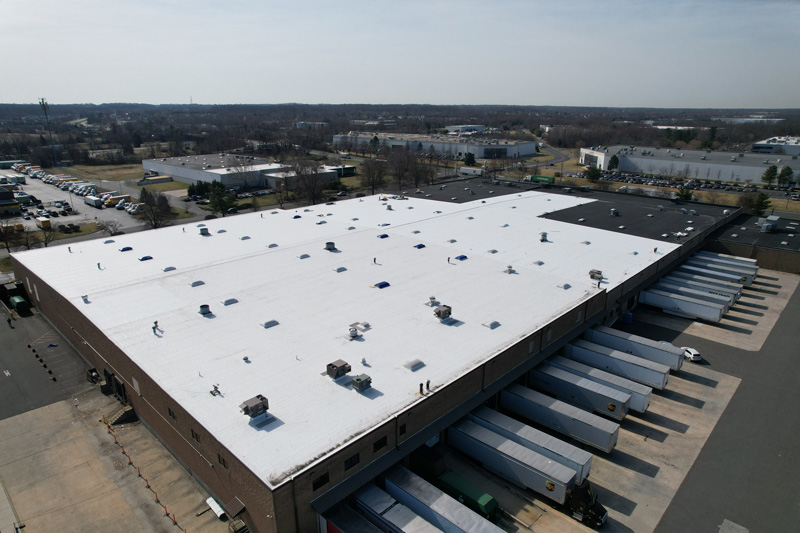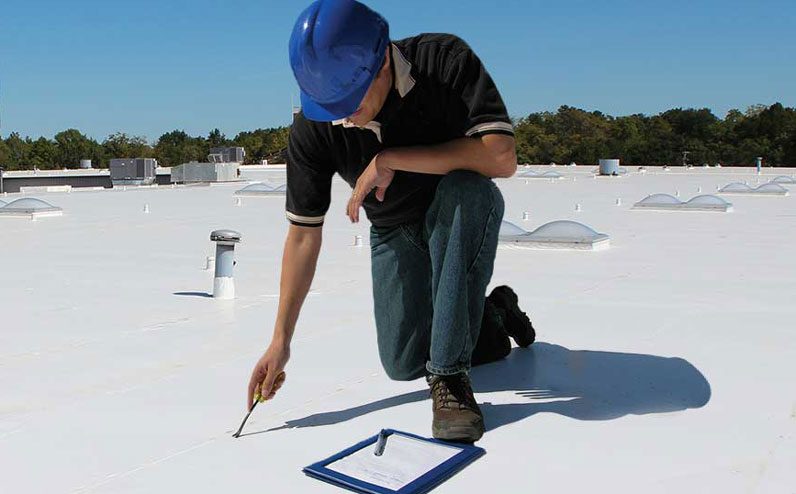
Ever glanced up at your building and wondered if that roof is doing more than just keeping the rain out? You’re not alone. The truth is, what’s happening up top influences everything from your building’s structural integrity to its overall design aesthetic. Choosing the right commercial roofing isn’t just about picking a material that looks good—it’s about making a decision that will affect your building’s performance for decades. The wrong choice? You might be staring down costly repairs and structural issues sooner than you think.
The Hidden Relationship Between Roofing and Building Design
Your roof isn’t just sitting up there minding its own business—it’s actively interacting with every aspect of your building’s design. Think of it as the crown that completes the outfit, not an afterthought.
Weight Distribution: The Balancing Act
Here’s something most building owners overlook: roofing materials have dramatically different weights. And those differences? They fundamentally change how your building needs to be designed. Take built-up roofing (BUR), for instance. At 3-5 pounds per square foot, it demands serious structural support. Compare that to a single-ply membrane weighing in at just 1-2 pounds, and suddenly your engineers are working with a completely different equation.
| Roofing Material | Weight per Square Foot | Structural Requirement |
| Built-Up Roofing (BUR) | 3-5 pounds | High |
| Single-Ply Membrane | 1-2 pounds | Low to Moderate |
| Metal Roofing | 1-3 pounds | Moderate |
“We’ve seen projects where building owners had to completely redesign their support systems after switching roofing materials,” notes a veteran commercial roofing expert with over 20 years of experience. “It’s not just about the roof—it’s about how everything underneath responds to it.”
Climate Considerations: When Weather Dictates Design
Consider a recent project in Minnesota where architects initially specified a roofing system better suited for Florida. Big mistake. In regions with heavy snowfall, your roof needs the structural integrity to handle thousands of pounds of snow accumulation. Meanwhile, in hotter climates, reflective roofing materials can slash cooling costs by up to 30%. That’s not just good design—that’s smart business.
Commercial Roof Impact on Building Engineering
Your commercial roof doesn’t just sit there looking pretty—it’s an active player in your building’s overall engineering equation.
Load-Bearing Calculations: The Science Behind Support
Getting load-bearing calculations wrong isn’t just a theoretical problem—it’s the difference between a roof that lasts 30 years and one that fails prematurely. When calculating load-bearing capacity, experienced engineers factor in:
- Dead loads (the permanent weight of the roof itself)
- Live loads (temporary weight from maintenance workers, equipment)
- Environmental loads (snow, rain, wind pressure)
These aren’t just numbers on paper—they’re the guardrails keeping your building safe.
Expansion and Contraction: The Dance of Materials
Imagine wearing shoes that grow and shrink throughout the day. Uncomfortable, right? That’s what happens to your roofing materials as temperatures fluctuate. Different materials have different thermal expansion rates. Metal roofing can expand significantly on hot days, while membrane roofing tends to remain more dimensionally stable. Without accounting for this movement in your building design, you’re inviting cracks, leaks, and structural issues.
Water Management: The Silent Building Killer
Water is relentless. Give it a 1/16-inch gap, and it will find its way inside your building, causing thousands in damage. Proper drainage systems aren’t a luxury—they’re essential infrastructure. A flat commercial roof with inadequate drainage can hold thousands of gallons of water, adding massive weight stress to your structure. Even worse, that pooling water will eventually find its way inside, causing damage that cascades through your building systems.
How Different Roofing Materials Shape Building Decisions
Each roofing material brings its own set of benefits and challenges to your building design. Choosing wisely means understanding these dynamics.
Metal Roofing: Lightweight Champion
Metal roofing has surged in popularity for good reason. Its lightweight profile (1-3 pounds per square foot) makes it ideal for buildings with less robust structural support. For architects pushing design boundaries with complex angles and overhangs, metal provides flexibility that heavier materials simply can’t match. Beyond weight, metal roofing reflects solar radiation rather than absorbing it, reducing cooling loads by up to 25% in summer months. For a 50,000 square foot commercial building, that could mean tens of thousands in energy savings annually.
Built-Up Roofing and Modified Bitumen: The Traditional Powerhouses
Sometimes there’s no substitute for proven performance. Built-up roofing (BUR) and modified bitumen have been commercial roofing staples for decades because they deliver exceptional waterproofing through multiple protective layers. The trade-off? These systems can weigh between 3-5 pounds per square foot—requiring substantially more structural support. For buildings with generous load capacity, this extra weight isn’t a problem. But for structures with limited support capabilities, these traditional systems might require costly structural enhancements.
Single-Ply Membrane Systems: Flexibility Meets Performance
Single-ply membranes like EPDM, PVC, and TPO offer compelling benefits for modern commercial buildings. Their lightweight profile (1-2 pounds per square foot) puts minimal stress on your structure, while their flexible nature allows them to accommodate building movement without compromising waterproofing integrity. Single-ply systems have been successfully installed on everything from massive distribution centers to architecturally complex corporate headquarters. Their versatility makes them a go-to option for buildings where weight considerations are paramount.
Green Roofing and Solar Integration: The Future Demands Support
Green roofs and solar panels represent the cutting edge of commercial roofing, but they come with significant structural implications. A saturated green roof can weigh upwards of 50 pounds per square foot—demanding exceptionally robust structural support. Similarly, solar panel arrays add both dead load (permanent weight) and wind uplift considerations to your roof design. According to commercial roofing specialists like L&L Commercial Roofing, these advanced roofing options require early integration into the building design process rather than being treated as afterthoughts. Working with experienced roofing consultants during the design phase can ensure your building has the necessary structural capacity for these sustainability features.
Practical Design Considerations for Your Commercial Building
Smart building design isn’t just about aesthetics—it’s about creating structures that perform efficiently and cost-effectively over decades.
Energy Efficiency: The Insulation Equation
Energy efficiency starts at the top. A well-insulated commercial roof can reduce energy consumption by 15-30%, depending on your climate and building usage.
| Insulation Type | R-Value | Energy Savings |
| Fiberglass | R-2.9 to R-3.8 per inch | Up to 30% |
| Spray Foam | R-6.0 to R-7.0 per inch | Up to 50% |
| Reflective Insulation | R-2.0 to R-4.0 | Up to 25% |
These aren’t just numbers—they translate directly to your bottom line. A 100,000 square foot commercial building in the Midwest might save $40,000 annually with proper roof insulation.
Building Code Compliance: Navigating the Regulatory Maze
Building codes aren’t suggestions—they’re requirements with teeth. And when it comes to commercial roofing, these codes cover everything from fire resistance to wind uplift resistance. What’s tricky? These codes vary dramatically by location and are constantly evolving. What was compliant last year might not meet this year’s standards. Working with roofing specialists who understand local code requirements can save you from costly compliance issues down the road.
Making Informed Roofing Decisions for Long-Term Success
Your commercial roof represents roughly 2-3% of your initial building cost but accounts for nearly 70% of building-related maintenance and problems. Getting it right isn’t just smart—it’s essential. When evaluating roofing options, consider:
- Weight implications for your structure
- Climate compatibility with your location
- Energy efficiency benefits and long-term savings
- Maintenance requirements over the system’s lifespan
- Code compliance for your specific jurisdiction
The right commercial roofing choice integrates seamlessly with your building’s design while providing decades of reliable performance. Make that choice with care, ideally with input from experienced roofing professionals who understand the complex interplay between roofing systems and building design.

FAQ
What are the key factors to consider when evaluating the impact of a commercial roof on building design and structure?
Focus on weight considerations, climate appropriateness, and load calculations when evaluating roofing impacts. Don’t overlook water management systems—they’re crucial for protecting your building’s integrity over time.
How do different roofing materials influence structural decisions in commercial building design?
Each material brings unique challenges—metal roofing is lightweight but expands more with temperature, while built-up roofing provides excellent protection but requires substantial structural support. Factor these characteristics into your initial design decisions.
What role does energy efficiency play in commercial roof design?
Energy efficiency is a major economic driver in roof design. With proper insulation and reflective materials, your roof can reduce energy costs by 15-30%—a significant impact on your building’s operational expenses over its lifetime.
How can I ensure that my commercial roof complies with building codes and regulatory standards?
Work with design professionals and contractors who specialize in commercial roofing and stay current with local building codes. Requirements change frequently, and non-compliance can result in costly retrofits or legal complications.
What are the benefits of consulting with roofing experts when designing a commercial roof?
Roofing specialists bring practical experience that complements architectural vision. They can identify potential issues before they become expensive problems and suggest solutions that optimize performance while respecting design intent.
How do climate considerations impact the design and structure of a commercial building’s roof?
Climate dictates everything from slope requirements to material selection. In snow-prone regions, roofs need adequate slope and structural support, while hot climates benefit from reflective materials that minimize heat absorption.
What are the structural implications of installing a green roof or solar integration on a commercial building?
These sustainable options add significant weight and complexity to roof design. Green roofs can weigh 35-100 pounds per square foot when saturated, requiring substantial structural reinforcement. Solar arrays add both dead load and wind uplift considerations that must be addressed in the building’s structural system.
Conclusion: The Roof as Your Building’s Crown Jewel
A commercial roof does far more than just keep the elements out—it actively shapes your structure’s performance, efficiency, and lifespan. Every roofing decision ripples throughout your building’s lifecycle, influencing structural integrity, operational costs, and even occupant comfort. Your roof represents an untapped opportunity. Whether you opt for reflective materials that slash cooling bills, integrate solar panels that generate revenue, or install a green roof that manages stormwater, what was once a simple weather barrier can become a performance-enhancing asset with measurable returns. The best roof designs aren’t afterthoughts—they’re baked into the initial building concept. Making roofing decisions early yields the greatest benefits at the lowest costs. When you treat your roofing system as a critical design element rather than just “what goes on top,” you create a more cohesive, efficient, and resilient building that delivers value for decades.
